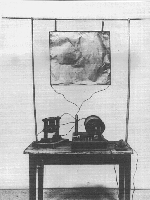1895: MARCONI'S INVENTION

The radio was born to the sound of a rifle shot. By September 1895, Guglielmo Marconi, a self-taught 21-year-old from Bologna, had already performed simple experiments which had convinced him that it was possible to send signals by using electromagnetic waves to connect a transmitting, and a receiving antenna. At first, the distances were short; the one hundred metres between his house and the end of the garden; but it then became necessary to demonstrate that, by using the ether, transmission was also possible between two points separated by an obstacle. Scientists and other experts held that electromagnetic waves could only be transmitted in a straight line and then only if there was nothing in the way. Above all, they thought that the main obstacle was the curvature of the earth's surface. Marconi, (like every self-taught man) was more interested in practice than theory, and so he placed his transmitter near his house and the receiver three kilometres away, behind a hill. Overseeing it, there was the Marconi's servant, Mignani, whose only duty consisted in firing a rifle shot when the signal was received. When Mignani fired his gun, for the first time in history the three dots of the letter "S" of the Morse alphabet had travelled through space. Marconi found little enthusiasm for his invention in Italy: thc appropriate Italian minister even considered that it was "not suitable for telecommunications"!

First Marconi's radiotrasmitter used in Villa Grifone, Bologna
However, in England, where his mother was born, Marconi was supported and financed and was able to patent his invention. In 1897, the British Ministry of Posts gave him money and technicians to continue his experiments and transmission distances became longer and longer: five, eight, fifteen, 30 and 100 kilometres. Radiotelegraphy had become a reality.
 back to home page
back to home page